
A corvette is a small warship. It is traditionally the smallest class of vessel considered to be a proper warship. The warship class above the corvette is that of the frigate, while the class below was historically that of the sloop-of-war.
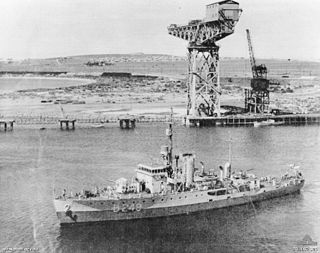
HMAS Pirie (J189/B249/A123), named for the city of Port Pirie, was one of 60 Bathurst-class corvettes constructed during World War II and one of 20 built on Admiralty order but manned by personnel of and commissioned into the Royal Australian Navy (RAN).

The Soviet Navy was the naval warfare uniform service branch of the Soviet Armed Forces. Often referred to as the Red Fleet, the Soviet Navy made up a large part of the Soviet Union's strategic planning in the event of a conflict with the opposing superpower, the United States, during the Cold War (1945–1991). The Soviet Navy played a large role during the Cold War, either confronting the North Atlantic Treaty Organization in western Europe or power projection to maintain its sphere of influence in eastern Europe.

The Romanian Naval Forces is the principal naval branch of the Romanian Armed Forces and operates in the Black Sea and on the Danube. It traces its history back to 1860.
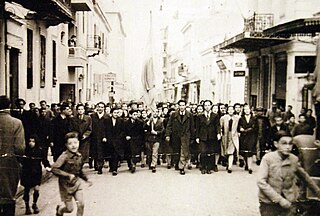
The Greek resistance involved armed and unarmed groups from across the political spectrum that resisted the Axis occupation of Greece in the period 1941–1944, during World War II. The largest group was the Communist-dominated EAM-ELAS. The Greek Resistance is considered one of the strongest resistance movements in Nazi-occupied Europe, with partisans, men and women known as andartes and andartisses, controlling much of the countryside prior to the German withdrawal from Greece in late 1944.
The history of the Hellenic Navy begins with the birth of modern Greece, and due to the maritime nature of the country, this force has been the premier service of the Greek Armed Forces.

HMAS Voyager (D31/I31) was a W-class destroyer of the Royal Navy (RN) and Royal Australian Navy (RAN). Commissioned into the RN in 1918, the destroyer remained in RN service until 1933, when she was transferred to the RAN. Recommissioned, Voyager served in the Mediterranean and Pacific theatres of World War II until 23 September 1942, when she ran aground while trying to deliver troops to Timor. The ship was damaged by Japanese bombers while trying to refloat, then was scuttled by her crew.

The Royal Indian Navy mutiny or revolt, also called the 1946 Naval Uprising, is a failed insurrection of Indian naval ratings, soldiers, police personnel and civilians against the British government in India. From the initial flashpoint in Bombay, the revolt spread and found support throughout British India, from Karachi to Calcutta, and ultimately came to involve over 10,000 sailors in 56 ships and shore establishments. The mutiny failed to turn into a revolution because sailors were asked to surrender after the British authorities had assembled superior forces to suppress the mutiny.

The Norwegian armed forces in exile were remnants of the armed forces of Norway that continued to fight the Axis powers from Allied countries, such as Britain and Canada, after they had escaped the German conquest of Norway during World War II.

The Free French Naval Forces were the naval arm of the Free French Forces during the Second World War. They were commanded by Admiral Émile Muselier.
Petros Voulgaris was a Greek Admiral who served briefly as Prime Minister of Greece in 1945. He was famous for his role in suppressing the 1944 Greek naval mutiny and restoring the fleet to combat readiness, for which he was awarded the Commander's Cross of the Cross of Valour.
The Black Sea Campaigns were the operations of the Axis and Soviet naval forces in the Black Sea and its coastal regions during World War II between 1941 and 1944, including in support of the land forces.
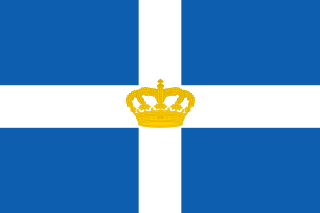
The Greek government-in-exile was formed in 1941, in the aftermath of the Battle of Greece and the subsequent occupation of Greece by Nazi Germany and Fascist Italy. The government-in-exile was based in Cairo, Egypt, and hence it is also referred to as the "Cairo Government". It was the internationally recognised government during the years of the Axis occupation of Greece.
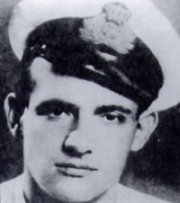
Nikolaos Roussen was a Greek naval officer who distinguished himself during World War II. He served in the two most successful Greek submarines of the war as executive officer and captain. He died during the suppression of the Navy mutiny in April 1944.

The Adriatic campaign of World War II was a minor naval campaign fought during World War II between the Greek, Yugoslavian and Italian navies, the Kriegsmarine, and the Mediterranean squadrons of the United Kingdom, France, and the Yugoslav Partisan naval forces. Considered a somewhat insignificant part of the naval warfare in World War II, it nonetheless saw interesting developments, given the specificity of the Dalmatian coastline.
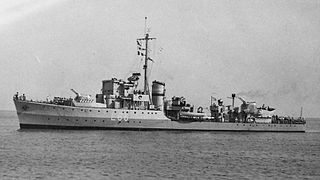
Pindos was a Type III Hunt-class destroyer that was originally built for the British Royal Navy as HMS Bolebroke but never commissioned. Before her completion, she was transferred to the Royal Hellenic Navy and commissioned on 27 June 1942 as Pindos in order to relieve heavy losses of ships sustained by the Royal Hellenic Navy during the German invasion of 1941. Pindos served in the Mediterranean Theatre throughout the Second World War. On 22 August 1943, along with HMS Easton, she sank the German U-boat U-458 off Pantelleria. Konstantinos Engolfopoulos served as executive officer during this period.

The 1936 Naval Revolt or Tagus boats mutiny was a mutiny in Portugal that occurred on 8 September 1936 aboard the aviso Afonso de Albuquerque and destroyer Dão. It was organized by the Revolutionary Organization of the Fleet, a left-wing group with links to the Portuguese Communist Party.

After the fall of Greece to the Axis powers in April–May 1941, elements of the Greek Armed Forces managed to escape to the British-controlled Middle East. There they were placed under the Greek government in exile, and continued the fight alongside the Allies until the liberation of Greece in October 1944. These are known in Greek history as the Greek Armed Forces in the Middle East.
Pyrros Lappas was a Greek Navy officer. He served in the Asia Minor Campaign, commanded warships in World War II, and assumed senior leadership positions in the post-war navy, culminating as Chief of the Hellenic Navy General Staff in 1952–1958. He then served for two years as head of the Military Household of King Paul of Greece, as General Secretary of the Hellenic Olympic Committee in 1961–1968, and as a member of the International Olympic Committee (1965–1980).
Red Terror is a term used by some historians to describe incidents of violence against civilians that were considered "traitors" by EAM, because these civilians allegedly collaborated with groups that wanted Greece to be under the political, economic and military influence of other foreign forces; either of Axis powers, from 1943 to 1944 or under British influence, from 1943 to 1949 and during the Greek Civil War. In the countryside, operations were conducted by the ELAS; in cities, by the Organization for the Protection of the People's Struggle (OPLA).















